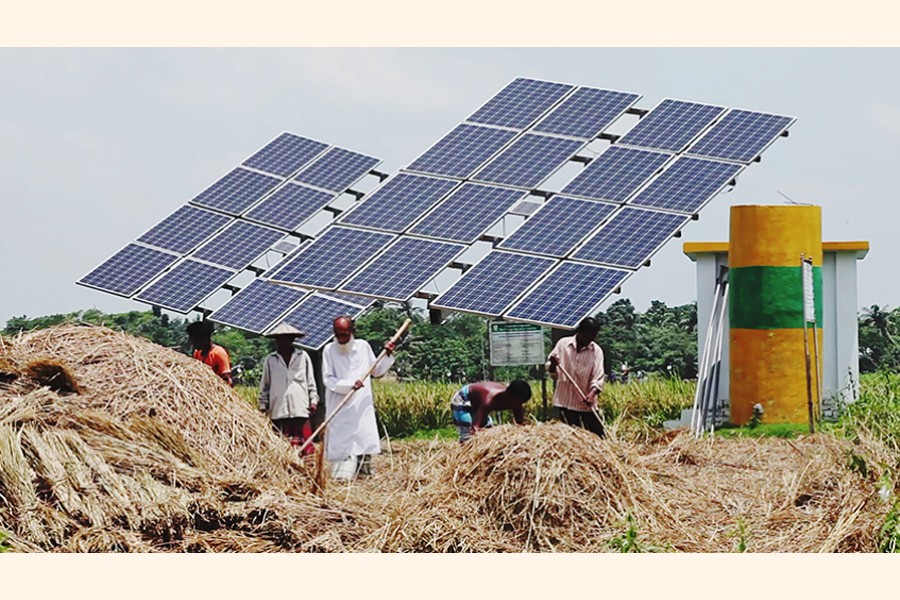Power generation has got significant boost in Bangladesh thanks to the bold initiative of the current government. It increased from less than 5,000 megawatts (MW) in 2010 to more than four times to 23,000MW in 2019. The 2016 Power Sector Master Plan (PSMP) projects a generation capacity of 60,000MW by 2041.
Renewable energy, unfortunately, has only 3 per cent share in the current grid mix due to fossil fuel-based development. It is widely considered that Bangladesh has limited potential for renewable energy sources. The 2016 PSMP identified land shortage as a major constraint for harvesting solar energy and meteorological conditions as a constraint for reaping wind energy.
The assessed potential for solar energy is 2,690MW and that of wind energy 637MW. With the addition of little biomass and hydropower, the total renewable energy potential is 3,666MW, which is only 6 per cent of the 2041electricity need, if the full potential is utilised.
The stated scenario is very depressing, when more than 60 per cent of the global power generation capacity (since 2014) is from the renewable sources. As one of the most vulnerable countries to the climate change phenomena, Bangladesh must strongly focus on renewable energy sources to rise up to the need of climate change action.
Recent developments in the solar power technology show great hope for meeting almost 100 per cent power demand of the country from this source. Floating solar panel on water bodies has seen a rapid growth since 2016 in different countries because of its advantages like higher efficiency and land saving.
The floating solar system produces more electricity than the fixed land-based system. This is because of lower module temperature in the vicinity of water and the opportunity of turning the panels towards the sun as the day passes. Projects in different countries produce up to 1.5MW per hectare depending on the type of solar cell. However, for the assessments in this article 1.0MW per hectare is considered.
Bangladesh has an estimated 150,000 hectares of ponds. If one-third of these ponds can be used for floating solar system; solar panels covering up to a third of each pond can give a total power generation of 15,000MW. The shade of the panels may help increased fish production too by reducing evaporation loss in the dry season.
Bangladesh is also rich with a good number of shallow water bodies like bills, haors and baors having a total area of more than 250,000 hectares. Government has taken initiatives to create sanctuaries for preserving native fish and other aquatic animals in these water bodies. If 10 per cent of their areas can be declared sanctuary, then that part can be effectively leased out for floating solar system to generate 25,000MW power.
There are opportunities in 70,000-hectare Kaptai lake and thousands of hectares of river pockets throughout the country. It is learnt that the government has already started planning for two floating solar power projects with a total capacity of 50MW backed by Asian Development Bank; one in the Padma river and the other in Kaptai lake. It can be assumed that these water bodies are able to add another 20,000MW. So, the total need of 60,000MW power is possible to generate from various floating solar system only.
Regarding the land-based option, the total roof system in Bangladesh has an area of around 500,000 hectares. Some housing projects in Germany presented delicate roof system with 100 per cent solar panel coverage. So, use of only 10 per cent of our roof system can give 25,000MW. It is based on a generation capacity of 500KW (0.5MW) per hectare for fixed panels on the roof system.
The cost of installation of the floating system is up to 25 per cent higher than the land system, but can be offset by higher efficiency. Overall, the cost of solar system is decreasing rapidly. In 2015 the cost of installation was $135 per megawatt hour (MWh), which is expected to be in between $44.50 and $61.50 per MWh in 2020.The expensive energy storage system for night-time use is also expected to be 80 per cent cheaper by 2040-- thanks to aggressive research investments across the world.
The cost of solar system development in Bangladesh would be further cheaper due to low labour cost. The growing industrial prowess of the country would also help manufacture floating pontoons, solar panels, and other accessories locally. The resulting employment generation and value addition will be significant to the national economy.
Many countries including neighbouring India has a target to achieve 40 per cent clean energy by 2030. Bangladesh, expected to be a developed country by 2041, needs to take initiatives accordingly for sustainable energy supply. A review of the 2016 PSMP is, therefore, required to change the direction from fossil fuel focus development to renewable energy taking advantage of the emerging technologies.
There are some challenges to tap the opportunities stated above, but it is not hard to overcome with appropriate and timely government policy initiatives. An early action is essential, else substantial economic setback from premature decommissioning of some expensive fossil fuel-based power plants, still to be constructed, would be a bottleneck to progress. In this era of fast-moving technology, a flexible policy mechanism of observing, picking, reviewing, deciding, and updating is required to be in place. 2016 PSMP is already five years old!
Dr. Shafiq Alam is Sustainable Infrastructure Specialist, Australia.


